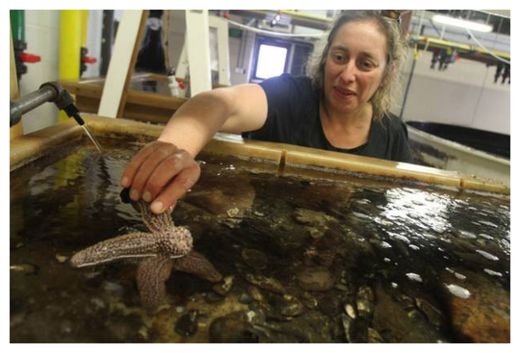
Following a boom in their population only a few years ago, starfish have since become so scarce that researchers in Rhode Island are even having difficulty collecting enough of them to study an unidentified disease that may be linked to their die-off.
"It's one of those mystery detective stories," said Marta Gomez-Chiarri, a biology professor at the University of Rhode Island in the department of fisheries, animal and veterinary science.
The case of the disappearing starfish, also known as sea stars, began more than a year ago when Caitlin DelSesto, then an undergraduate student at URI, began collecting starfish for a project on how they respond to ocean acidification, a symptom of climate change.
She quickly ran into a serious problem. Many were slimy, mushy, and plagued with white lesions. Some, for no apparent reason, released their iconic appendages, which famously regenerate when healthy. Within a week of being placed in tanks, most seemingly melted and died.
DelSesto soon learned that their numbers were dwindling considerably. Only a few years earlier, there were so many starfish around that farmers raising oysters and researchers trying to restore wild scallop populations feared the abundance of the shellfish-eating predators. Gomez-Chiarri recalls seeing time-lapse video at that time of a "wave of sea stars going through a site and eating all of the mussels and leaving a wasteland afterwards."
Now it's starfish that are vanishing, a phenomenon that has gone largely unnoticed since they live mostly out of sight and because fishermen who have no use for them aren't looking for them.
But Gomez-Chiarri and DelSesto, who decided to research the mystery as a graduate student, have since heard from numerous experts that starfish populations have seemingly crashed all the way from New Jersey to Maine. Aquariums, for example, have reported difficulty maintaining starfish exhibits.
The URI researchers were able to obtain a $40,000 grant from the Rhode Island Science and Technology Advisory Council to study the issue with scientists at Brown University and Roger Williams University.
"As far as I know, nobody else has been working on this," said Gomez-Chiarra.
While they don't have commercial value, it's important to understand what's happening with starfish since they are a key part of the ecosystem, she said. As an example, she cited a collapse in sea urchin populations in the Caribbean several years ago. The decline of the algae-munching urchins led to corals being smothered by algae.
"A boom or a crash on a predator could have cascading effects," Gomez-Chiarra said.
The team is asking for the public's help since it can't study the disease without specimens.
"We are at the start of collecting sea stars, which is a problem because there are not that many out there right now," said Gomez-Chiarri. "So far we don't have enough to conduct all of the experiments."
Divers especially are being asked to keep a lookout for starfish colonies - healthy or diseased - and to report their exact location and number to DelSesto at cdelsesto@my.uri.edu. The team will then have its divers collect samples.
The research team includes Rogers Williams marine pathologist Roxanna Smolowitz, who is examining starfish tissues; URI marine scientist Ed Baker, who is studying environmental conditions and trying to culture the pathogen; and Brown molecular biologist Gary Wessel, who is analyzing bacteria on and inside the starfish. Wessel, in one study, put diseased starfish from the East Coast into a tank with healthy starfish from California. The healthy ones eventually became ill and died, confirming suspicions about the role disease may be playing in the population collapse.
"It could be something that happens every once in a while," said Gomez-Chiarra, noting that populations have collapsed here and elsewhere in the past. "It could be a combination of a stress or lack of nutrition ... or a sign of a bigger problem."



Reader Comments
to our Newsletter